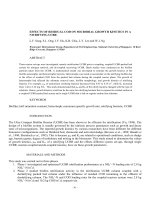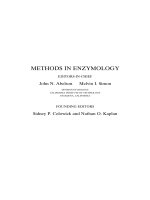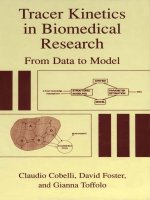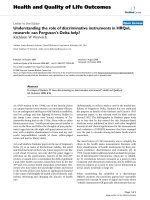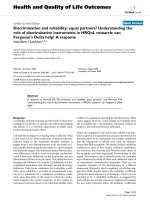tracer kinetics in biomedical research
Bạn đang xem bản rút gọn của tài liệu. Xem và tải ngay bản đầy đủ của tài liệu tại đây (8.25 MB, 469 trang )
Tracer Kinetics in
Biomedical Research
This page intentionally left blank.
Tracer Kinetics in
Biomedical Research
From Data to Model
Claudio Cobelli
University of Padova
Padova, Italy
David Foster
University of Washington
Seattle, Washington
and
Gianna Toffolo
University of Padova
Padova, Italy
KLUWER ACADEMIC PUBLISHERS
NEW YORK, BOSTON, DORDRECHT, LONDON, MOSCOW
eBook ISBN: 0-306-46833-6
Print ISBN: 0-306-46427-6
©2002 Kluwer Academic Publishers
New York, Boston, Dordrecht, London, Moscow
All rights reserved
No part of this eBook may be reproduced or transmitted in any form or by any means, electronic,
mechanical, recording, or otherwise, without written consent from the Publisher
Created in the United States of America
Visit Kluwer Online at:
and Kluwer's eBookstore at:
Preface
The use of mathematical modeling techniques in biomedical research
is playing an increasingly important role as one seeks to understand the
physiopathology of disease processes. This includes not only understand-
ing mechanisms of physiological processes, but diagnosis and treatment.
In addition, its introduction in the study of genomics and proteomics
is key in understanding the functional characteristics of gene expression
and protein assembly and secretion. Finally, with the increasing com-
plexity and associated cost of drug development, modeling techniques
are being used to streamline the process.
We have worked in close collaboration with colleagues in biomedical
and pharmaceutical research for a number of years applying and refining
mathematical modeling techniques to a variety of problems. In addition,
we have worked in collaboration with colleagues in applied mathematics
and statistics to develop new algorithms to solve new sets of problems
as they emerge in our research efforts. Finally, we have worked with
colleagues in computer science to develop new software tools that bring
the power of mathematical modeling to a broad research community.
This books brings together much of what we have learned over the years,
and presents the material in a format that should be accessible both to
the novice reader and those desiring more detailed information about
specific techniques.
We are indebted to many of our colleagues who were extremely patient
and helpful during the preparation of the book for publication. We
are encouraged by the support we have received from our respective
institutions and also review panels for several of the research grants we
have obtained during the work on the book.
There are many research programs that have led directly to material
presented in the text. Special mention must be given to the Biomedical
Technology Program in the National Center for Research Resources at
v
vi TRACER KINETICS IN BIOMEDICAL RESEARCH
the National Institutes of Health (USA) whose resource facility grant
Resource Facility for Kinetic Analysis (RFKA) supported all authors
during the development of the SAAM II software system. There is a
tight link between the material developed in this text and SAAM II;
SAAM II was used to develop all examples in the text.
The preparation of the book would not have been possible without
regular travel between Seattle and Padova. Funding for the travel was
provided by RFKA and the Ministero della Università e Ricerca Scien-
tifica e Tecnologica of Italy. We are most grateful for this support.
Finally, we would like to thank Agnes Sieger and Mike Macaulay for
the final preparation of the text.
CLAUDIO CODELLI, PADOVA,ITALY
DAVID FOSTER, SEATTLE, WASHINGTON, USA
G
lANNA
T
OFFOLO
, P
ADOVA
, I
TALY
Contents
1.
2.
3.
INTRODUCTION
1.1
1.2
1.3
1.4
1.5
Why Modeling?
How Modeling?
Aim of the Book
Who Should Read the Book?
Organization of the Book
FUNDAMENTALS OF TRACER KINETICS
2.1
2.2
2.3
2.4
2.5
2.6
Introduction
The Tracer-Tracee System
2.2.1
2.2.2
2.2.3
2.2.4
2.2.5
Concepts and definitions
The tracee system
The tracer system
The tracer-tracee system
System parameters from tracer and tracee
measurements
The Tracer-Tracee System with Isotopic Tracers
2.3.1
2.3.2
Concepts and definitions
Relationships among isotopic variables
The Radioactive Tracer Variables
2.4.1
2.4.2
Measurements
Kinetic variables
The Stable Isotope Tracer Variables
2.5.1
2.5.2
2.5.3
2.5.4
Measurements
Kinetic variables
The multiple species case
A test of the endogenous constant
assumption
Multiple Tracer Experiments
THE NONCOMPARTMENTAL MODEL OF MULTIPOOL
SYSTEMS: ACCESSIBLE POOL AND SYSTEM PARMETERS
3.1 From Single to Multipool Systems
vii
1
1
3
5
5
6
11
11
12
12
15
17
19
19
21
21
24
25
25
27
28
28
31
33
35
37
39
39
viii TRACER KINETICS IN BIOMEDICAL RESEARCH
4.
5
.
3.2
3.3
3.4
Kinetic Parameters of the Accessible Pool
3.2.1
3.2.2
Definitions
Formulas
Kinetic Parameters of the System
3.3.1
3.3.2
3.3.3
3.3.4
Definitions
Formulas
Limitations of noncompartmental models
Parameters from total body tracer measurements
The Two Accessible Pool Noncompartmental Model:
Accesssible Pool and System Kinetic Parameters
3.4.1
3.4.2
3.4.3
3.4.4
3.4.5
3.4.6
Introduction
The two input - four output experiment for
radioactive and stable isotope tracers
The accessible pool kinetic parameters: Definitions
and formulas
System parameters: Definitions and formulas
Relationship between one and two accessible pool
noncompartmental models
Limitations of two accessible pool noncompart-
mental models
THE COMPARTMENTAL MODEL
4.1
4.2
4.3
4.4
4.5
4.6
Introduction
Concepts and Definitions
The Compartmental Model of a Tracer-Tracee System
4.3.1
4.3.2
4.3.3
4.3.4
Introduction
The one compartment model
The two compartment model
The n-compartment model
Structural Properties
4.4.1
4.4.2
4.4.3
4.4.4
4.4.5
Introduction
The compartmental matrix
The mean residence time matrix
Sums of exponentials and the compartmental
model
Non-negativity and stability properties of
compartmental model equations
Kinetic Parameters
Catenary and Mammillary Models
IDENTIFIABILITY OF THE TRACER MODEL
5.1
5.2
5.3
5.4
Introduction
Some Examples
Definitions
The Two Compartment Model
5.4.1
5.4.2
5.4.3
Introduction
Input into a single compartment
Input into both compartments
43
43
44
51
51
52
56
58
59
59
62
64
69
71
72
75
75
77
80
80
82
84
86
91
91
91
94
97
99
103
105
109
109
110
118
120
120
121
129
Contents
ix
6.
8.
5.5
5.6
5.7
5.8
5.9
The Laplace Transform Method: The Two Compartment
Model Revisited
5.5.1
5.5.2
Introduction
Example of the Laplace transform method
The Difficulty of the Identifiability Problem
The Three Compartment Model
Catenary and Mammillary Models
A Priori Identifiability of General Structure Compart-
mental Models: A Computer Algebra Approach
5.9.1
5.9.2
5.9.3
5.9.4
Introduction
Rationale
The transfer function topological approach
The identifiability algorithm
USING THE TRACER MODEL TO ESTIMATE KINETIC
PARAMETERS
6.1
6.2
6.3
Introduction
Estimation from A Priori Uniquely Identifiable Models
Estimation from Interval Identifiable Models
COMPARTMENTAL VERSUS NONCOMPARTMENTAL
KINETIC PARAMETERS
7.1
7.2
7.3
7.4
7.5
7.6
Introduction
The Mean Residence Time Matrix Revisited
Equivalence of the Accessible Pool Parameters
Nonequivalence of the System Parameters
Parameters of the Nonaccessible Pools
The Two Accessible Pool Model
7.6.1
7.6.2
Accessible pool parameters
System parameters
PARAMETER ESTIMATION: SOME FUNDAMENTALS
OF REGRESSION ANALYSIS
8.1
8.2
8.3
Introduction
8.1.1
8.1.2
The nature of the regression problem
Linear and nonlinear parameters
Basic Concents of Regression Analysis
8.2.1
8.2.2
8.2.3
The residual
Residual sum of squares
Weights and weighted residual sum of squares
The Assignment of Weights to Data
8.3.1
8.3.2
8.3.3
8.3.4
8.3.5
Introduction
Description of the error in the data
Weights and error variances
A model of the error variance
Estimating the parameters of the error model from
standard samples
132
132
133
135
139
143
148
148
151
151
153
165
165
168
179
191
191
192
194
200
207
208
208
209
215
215
216
220
221
221
222
224
225
225
226
227
228
231
x TRACER KINETICS IN BIOMEDICAL RESEARCH
8.3.6 Estimating the parameters of the error model from
replicates of the measurements
8.3.7 Propagation of errors
8.3.8 Estimating error model parameters from extended
least squares
8.4 The Fundamentals of Linear Regression
8.4.1 Data fitting and linear regression
8.4.2 Solving the linear regression problem
8.4.3 Weighted linear regression
8.4.4 The effect of weights on parameter estimates and
their precision
8.5 The Fundamentals of Nonlinear Regression
8.5.1 Introduction
8.5.2 The steps involved in nonlinear regression
8.5.3 The covariance and correlation matrices
8.5.4 Algorithms and software for nonlinear regression
8.5.5
The effect of weights
8.6 Tests on Residuals for Goodness of Fit
8.6.1 Introduction
8.6.2 Tests for independence of residuals
8.6.3 Test on the variance of the measurement error
8.7 Tests for Model Order
8.7.1 Introduction
8.7.2 Three tests for model order
8.7.3 Two case studies
8.8 Derived Statistics
9. PARAMETER ESTIMATION IN NONCOMPARTMENTAL
MODELS
9.1 Introduction
9.1.1 What is needed?
9.1.2 Numerical methods
9.1.3 Using sums of exponentials
9.2 The Single Accessible Pool Model: Formulas for Kinetic
Parameters
9.2.1 Introduction
9.2.2 The bolus injection
9.2.3 The constant infusion
9.2.4 The primed constant infusion
9.3 The Single Accessible Pool Model: Estimating the
Kinetic Parameters
9.3.1 Introduction
9.3.2 Example: Bolus injection
9.3.3 Example: Constant infusion
9.3.4 Example: Primed infusion
9.4 The Two Accessible Pool Model: Estimating the
Kinetic Parameters
9.4.1 Introduction
233
236
237
238
238
239
240
242
245
245
247
252
256
256
261
261
261
265
269
269
270
272
280
283
283
283
284
285
287
287
287
289
290
291
291
292
294
297
298
298
Contents xi
9.4.2 The bolus injection
9.4.3 The constant infusion
10. PARAMETER ESTIMATION IN COMPARTMENTAL
MODELS
10.1 Introduction
10.2 Nonlinear Least Squares Estimation
10.3 The Multiple Output Case
10.4 The Multicompartmental Model
11. PRECURSOR-PRODUCT MODELS
11.1 Introduction
11.2 Estimating the Fraction of Product Originating from the
Precursor: The Noncompartmental Model Approach
11.3 Estimating the Fractional Synthetic Rate: The Derivative
Approach
11.4 Estimating the Fractional Synthetic Rate: The Integral
Approach
11.5 Zilversmit’s Rule
Appendices
A. Relationships among Isotopic Variables
B. The Use of Enrichment in the Kinetic Formulas
C. Relationships between the Isotope Ratio and Tracer
to Tracee Ratio for Multiple Tracer Experiments
D. Derivation of Accessible Pool and System
Parameter Formulas
E. Derivation of the Exhaustive Summary
F. Table of Identifiability Results
G. Obtaining Initial Estimates of Exponentials
H. Relationships among the Parameters of Multiexponential
Models
I. Calculation of Model Output Partial Derivatives
J. Initial Estimates of the Rate Constants of
Multicompartmental Models
INDEX
298
304
307
307
310
313
314
337
337
338
340
346
350
355
359
363
369
379
381
385
433
437
441
455
This page intentionally left blank.
Chapter 1
INTRODUCTION
1.1 WHY MODELING?
The use of tracers to study metabolic systems is becoming increas-
ingly important in biomedical research. The fundamental reason is that
while the tools of molecular biology have provided much new informa-
tion about the structure of different components of metabolic systems,
information is also needed about the function of these components. This
information can come from a knowledge of the systems kinetics, that is,
the temporal and spatial distribution of the components comprising the
system. Tracers are used as a tool to obtain the kinetic information.
One reason why tracer kinetics is enjoying a resurgence is that signif-
icant improvements have been made in both the quality and quantity
of data that are available from a tracer experiment. This is due both
to new instruments to measure data previously not available and new
instruments, especially for stable isotopes, to measure kinetic informa-
tion in increasingly small samples. For example, PET and NMR studies
using radioactive and stable isotopes are revealing details of metabolic
events heretofore unavailable.
In general, tracer kinetic studies are undertaken to understand the
physiology and pathophysiology of the metabolism of substances that
already exist in the body. Such substances include glucose, insulin, vita-
mins, minerals, amino acids and proteins, or aggregates of material such
as the plasma lipoproteins. While studies are most commonly conducted
at the “whole body” level, new techniques are permitting studies at the
organ, cellular and subcellular levels.
In order to interpret kinetic data from an experiment, one requires a
mathematical model of the system under study. A model is a construct
1
2 TRACER KINETICS IN BIOMEDICAL RESEARCH
invented by a researcher to summarize what is known and hypothesized
about a system under study. It breaks the system down to a level of
detail required into component parts indicating the relationship among
these parts. A mathematical model is simply a model that can be de-
scribed by a set of mathematical equations.
Why is mathematical modeling necessary? It is necessary because
researchers desire quantitative information on the system under study.
Models provide a means by which to calculate parameters characterizing
these nonaccessible parts of the system from information available only
from those parts of the system that are accessible for measurement. The
situation can be schematized in Figure 1.1.1.
Thus to estimate these kinetic parameters, one has to link the infor-
mation available from the accessible pool measurements with the events
occurring in both in the accessible and nonaccessible portions of the
system. This requires making some assumptions about how the system
functions. In short, one has to postulate a model of the system based
upon known physiology and biochemistry, and assumptions about how
the system is interconnected. Once this is done, the model must be
described mathematically. The situation is illustrated in Figure 1.1.2.
Introduction 3
1.2 HOW MODELING?
How are these models constructed? As indicated in Figure 1.2.1, there
are basically two steps involved: structural modeling and parameter es-
timation. As mentioned previously, structural modeling is the process
by which ones knowledge and assumptions about the system are for-
malized first as a schematic and then mathematically. As will be seen
in this text, the model will always contain hypotheses and simplifica-
tions for a variety of reasons: parts of the system are unknown, or only
some features are relevant for the study. However, the model must be
parsimonious and usable. Parameter estimation is the process by which
the parameters characterizing the model are adjusted so as to obtain a
best fit of the available data. For any hypothesized structural model,
parameter estimation provides information to assess the adequacy of the
model. Criteria based upon goodness-of-fit, precision of the parameter
4 TRACER KINETICS IN BIOMEDICAL RESEARCH
estimates, parsimony, and plausibility permit an investigator to judge
the quality of the model.
The best one can hope for is a model to be compatible with the data
and be physiologically plausible. While never the truly “correct” model
of the system, it can be used for predictive purposes, e.g. estimating
the system parameters and simulating future experiments. However,
one must have confidence in the results and predictions of the model.
This confidence can be obtained through the process of validating the
model. Validation criteria and strategies are available which take into
account the models complexity and available data. The model is also
dynamic in the following sense. The hypotheses that are incorporated
in the models structure can be tested through new experiments. The
model will either correctly predict the results of these experiments or
not. If it does not, then the model structure will have to be changed,
and the process of compatibility with previous data and physiological
plausibility reexamined.
There are many types of mathematical models that can be used to
interpret tracer kinetic data. All have assumptions associated with them
that need to be understood in order to apply them correctly. In addition,
what type of model is chosen for a particular situation can depend upon
the information that is needed. Thus while a particular set of data could
be very rich in information content, a simple method of analysis could
be used to estimate a limited set of parameters.
Introduction
5
1.3 AIM OF THE BOOK
The aim of this book is to explain how mathematical models can be
used as a powerful research tool in the design and analysis of experiments
in which tracer kinetic data are generated. Starting with a description
of radioactive and stable isotopes, it will give a detailed description of
the steps involved in developing and using mathematical models.
The focus will be on systems that are studied in the steady state, since
most of the metabolic systems are non-linear, and this makes them diffi-
cult to study since the mathematical equations describing them are also
non-linear, and the nature of the non-linearities is difficult to describe
mathematically. To overcome this problem, many tracer kinetic stud-
ies are conducted in the steady state, i.e. under conditions where the
masses and fluxes of material in the system are maintained in near con-
stant conditions. This assumption results in mathematical models that
are linear and, with the numerical techniques now available in many
software programs, easy to solve.
Two common types of linear models will be presented: noncompart-
mental and (linear) compartmental models. The underlying assump-
tions of each will be explained in detail. The underlying mathematics
and statistics will also be explained, but at a level that is transparent
to the novice reader. They will be explained in terms that are easy to
understand. This is especially true in the areas of parameter estimation
and model identifiability, two areas that are critical in the process but
a poorly understood because most material in these areas is given in
full generality with little intuition as to the “what”, “how” and “why”.
Here the concepts will be explained in understandable terms; the con-
cepts will be carefully illustrated using several examples. The goal is that
the reader, upon completing the book, will be able to use mathematical
models and software programs necessary to solve them and use them as
powerful research tools. Since the modeling machinery is transparent,
it is also useful in other contexts. For example, it should be noted that
much of the material in the book is relevant to study pharmacokinetic/
pharmacodynamic systems, nonsteady state systems and physiological
control system.
1.4 WHO SHOULD READ THE BOOK?
Mathematical modeling has received considerable attention both in
the past and present kinetic studies. Many books and papers have been
written on the subject. The most frequently cited text include Anderson
[1983], Atkins [1969], Atkinson [1999], Carson et al. [1983], Gibaldi and
Perrier [1982], Godfrey [1983], Gurpide [1975], Jacquez [1996], Lassen
6 TRACER KINETICS IN BIOMEDICAL RESEARCH
and Perl [1979], Norwich [1977], Rescigno and Segre [1966], Riggs [1975],
Rowland and Tozer [1995], Shipley and Clark [1972], and Wolfe [1992].
In addition, there are several seminal articles including Carson and Jones
[1979], Cobelli and Caumo [1998], DiStefano and Landaw [1984], and
Landaw and DiStefano [1984].
Many of the texts listed above focus only on limited aspects of the
modeling process. Others go into mathematical and/or statistical depth
that is beyond the ability of the beginning modeler. In this book, empha-
sis is placed on aspects of analyzing tracer kinetic data obtained from in-
creasingly complex systems using increasingly sophisticated experimen-
tal designs. The mathematics involved will illustrate the key points,
especially in parameter estimation and model identifiability. However,
intuitive arguments will be given in many places so the reader will un-
derstand the assumptions and limitations of the various methodologies
discussed. When more detail is required, the reader will be pointed to
specific texts or the appendices.
With this in mind, who should read this book? The book is intended
for those individuals who are using or planning to use tracer kinetic
techniques to probe different metabolic systems. In addition, it can be
used as an introductory text in tracer kinetic analysis and mathematical
modeling of biological systems. Finally, it can be used by researchers
in pharmacokinetics who are interested in information in a more global
setting than that normally found in many pharmacokinetic text books.
Fortunately there are a number of software systems that are available
to aid the research in the model development and data analysis process.
Some users take advantage of mathematically oriented scientific software
packages; these require the user to write the models equations directly
and often require, in addition, programming skills. This level of usage is
beyond the scope of the present text so these packages will not be listed.
1.5 ORGANIZATION OF THE BOOK
This book provides a description of the processes involved in designing
and analyzing tracer kinetic studies starting from the steps involved in
choosing an isotope, or isotopes, for a tracer, or tracers, through formu-
lating models to analyze the kinetic data resulting from an experiment.
It begins with a description of the fundamentals of tracer kinetics fo-
cusing on the measurement variables, discusses two broadly used mod-
eling techniques including the underlying mathematics and statistics,
and discusses how to assess how “good” a model is. It also points out
how models can be used to test hypotheses both after an experiment is
completed, and before during which time experimental protocols can be
simulated before actually performing an experiment. Taken together,
Introduction
7
the goal is to obtain information rich data and then to apply modeling
techniques to extract the information.
When needed, specific references to more detailed information will be
given at the end of each chapter. These bibliographies are not meant to
be exhaustive nor historic. They are meant to provide specific supple-
mental information for those readers wanting more details about specific
material presented in the chapter.
Several examples are provided to illustrate key points. Two Case
Studies are discussed which permit a comparison of the different method-
ologies that are provided. A floppy disk with the data files used in the
examples and Case Studies is provided so that the reader can recre-
ate them. In this book the SAAM II software was used to generate all
examples and Case Studies.
Chapter 2 discusses the fundamentals of tracer kinetics first in gen-
eral terms, and then specifically related to radioactive and stable isotopic
tracers. Careful attention is paid to the measurement variables. Impor-
tant comparisons between the measurement variables for the two kinds of
tracers are made. In addition, a rigorous discussion concerning the var-
ious measurement variables for stable isotopic tracers is given. For the
readers convenience, a table is included that can help convert the usual
measurement variables for stable isotopic tracers into the measurement
variable that is needed for data analysis.
Chapters 3 and 4 describe the basics of the noncompartmental and
compartmental models of multipool systems. The former, often referred
to as the integral equation approach and claimed to be model indepen-
dent, is shown to be based upon many assumptions that are actually
shared, in part, by certain types of multicompartmental models. For
noncompartmental models, the standard formulas for the parameters are
derived for the different protocols using radioactive and stable isotopic
tracers. For compartmental systems, the basic definitions are given. In
both cases, it is assumed that the experiment is conducted in the steady
state. This will be seen to have a dramatic impact on multicompart-
mental models since the underlying differential equations have special
properties.
Chapter 5 focuses on the a priori identifiability of multicompartmental
models. This addresses the following question: given a specific model
structure and input-output protocol, will the data (in the ideal sense,
i.e. assuming the model structure is correct and the data are error free)
permit the estimation of the model parameters? Several examples will
be given to show how this crucial step fits into the modeling process. It
will be shown that new technologies are being developed which can help
to answer this question in the general case.
8 TRACER KINETICS IN BIOMEDICAL RESEARCH
Chapter 6 will show how to recover kinetic parameters from multi-
compartmental models, and in Chapter 7a comparison between these
parameters and those generated from noncompartmental models will be
given. The reader will see when the two agree, and under which cir-
cumstances they do not agree. It will be easy to understand how the
imposition of a structure in a multicompartmental model increases the
models predictive capability.
Chapter 8 discusses parameter estimation. This crucial chapter dis-
cusses unweighted and weighted linear and nonlinear regression. It will
be seen that while linear regression is exact, nonlinear regression is an
approximation. It describes in detail the error structure in the data, and
why it is essential that one appreciate this error in the modeling process.
It then goes on to discuss regression, and show why the error structure is
necessary if one desires statistical information about the fitting process.
The notions of standard and fractional standard deviations, variance-
covariance and correlations are also introduced. Chapter 8 ends with
a discussion of tests for goodness-of-fit and model order. To provide
insights into the regression process, simple examples are given.
Chapter 9 shows how to use sums of exponentials to estimate the pa-
rameters of the noncompartmental model. Several examples are given.
An appendix is provided which shows the reader how to obtain initial
estimates for the coefficients and exponentials in the exponential func-
tion.
Chapter 10 does the same for multicompartmental models. Again, an
appendix is provided to illustrate how to obtain initial parameter esti-
mates. This will again illustrate the critical link between the coefficients
and exponentials in the exponential function, and the rate constants of
a multicompartmental model. In both chapters, case studies will serve
as examples.
Chapter 11 describes a special application often found in tracer kinetic
analysis, precursor-product relationships. Here the equations are derived
with the assumptions specifically given allowing the reader to understand
fully the results from this type of analysis.
References
Anderson, D.H.: Compartmental Modeling and Tracer Kinetics. Springer-
Verlag, Berlin, 1983.
Atkins G.L.: Multicompartment Models for Biological Systems. Methuen,
London,1969.
Atkinson, Art. 1999.
Carson E.R.: Jones E.A.: The use of kinetic analysis and mathematical
modeling in the quantitation of metabolic pathways in vivo: Applica-
Introduction
9
tion to hepatic anion metabolism. N. Engl. J. Med.
300
:1016–1027,
1078–1086, 1979.
Carson E.R., Cobelli C., Finkelstein L.: The Mathematical Modelling of
Metabolic and Endocrine Systems
.
Wiley, New York, NY, 1983.
Cobelli C., Caumo A.: Using what is accessible to measure that which
is not: necessity of model of system. Metabolism 47:1009–1035, 1998.
DiStefano, J. III, Landaw E.M.: Multiexponential multicompartmental,
and noncompartmental modeling. I. Methodological limitations and
physiological interpretations. Am. J. Physiol. 246:
R651–R664
, 1984.
Gibaldi M., Perrier D.: Pharmacokinetics, 2nd ed. Marcel Dekker, New
York, NY, 1982.
Godfrey K.: Compartmental Models and Their Application.
Gurpide E.: Tracer Methods in Hormone Research. Springer-Verlag,
Berlin, 1975.
Jacquez J.A.: Compartmental Analysis in Biology and Medicine, 3rd ed.
BioMedware, Ann Arbor,MI, 1996.
Landaw E.M., DiStefano J.J. III: Multiexponential, multicompartmen-
tal and noncompartmental modeling. II. Data analysis and statistical
considerations. Am. J. Physiol. 246:R665-R677, 1984.
Lassen N.A., Perl W.: Tracer Kinetic Methods in Medical Physiology.
Raven Press, New York, NY, 1979.
Norwich K.H.: Molecular Dynamics in Biosystems: The Kinetics of Trac-
ers in Intact Organisms. Pergamon Press, Oxford, 1977.
Rescigno A., Segre G.: Drug and Tracer Kinetics. Blaisdell, Waltham,
MA,
1966.
Riggs D.S.: The Mathematical Approach to Physiological Problems.
Williams & Wilkins, Baltimore, MD, 1963 (available edition, MIT
Press, Cambridge, MA, 1975).
Rowland M., Tozer T.: Clinical Pharmacokinetics: Concepts and Appli-
cations, 3rd ed. Williams & Wilkins, Baltimore, MD, 1995.
Shipley R.A., Clark R.E.: Tracer Methods for in Vivo Kinetics
.
Academic
Press, New York, NY, 1972.
Wolfe R.R.: Radioactive and Stable Isotope Tracers in Medicine. Wiley-
Liss, New York, NY, 1992.
This page intentionally left blank.
Chapter 2
FUNDAMENTALS OF TRACER KINETICS
2.1 INTRODUCTION
As defined in Chapter 1, the kinetics of a substance in a biologi-
cal system are its spatial and temporal distribution in that system. The
kinetics are the result of several complex events including circulatory dy-
namics, transport into cells, and utilization. Utilization usually requires
biochemical transformations which are characteristics of the substance.
The substance can be an element such as calcium or zinc, or a compound
such as amino acids, proteins or sugars. All exist normally in the body,
and can be of endogenous or exogenous sources, or both. The primary
goal of the kinetic events characterizing the metabolism of a substance
is to maintain specific levels of the substance in the various components
of its systems. The maintenance of these levels is achieved by internal
control mechanisms, and involves input into the system to balance the
loss which occurs through utilization and excretion.
One wishes to understand the kinetics of a substance under normal
circumstances in order to better understand pathophysiological condi-
tions since these may be a result of abnormal kinetics. A fundamental
problem in biology and medicine, therefore, is to describe quantitatively
the kinetics of substances existing in the body. Among the tools that
are available, tracers have been extensively used. Tracers are substances
introduced externally into the system to provide data from which quan-
titative estimates of events characterizing the kinetics of the substance
can be made. Tracers can be substances such as dyes or, as described in
more detail below, substances labeled with radioactive or stable isotopes.
In this text, the focus will be on characterizing the kinetics of sub-
stances already present in the body by using isotopic tracers as probes.
11
12
TRACER KINETICS IN BIOMEDICAL RESEARCH
A naturally occurring substance is called a tracee. The tracers will
be assumed to be ideal where an ideal tracer is a substance with the
following characteristics:
a.
it is detectable by an observer,
b. its introduction into a system does not perturb the system being
studied, and
c.
it is indistinguishable with respect to the properties of the tracee
system being studied.
The first requirement, that of detectability, means that there must
be some method by which the amount of tracer in a sample can be
quantified. The second requirement means that the introduction of a
tracer into the system has no effect on the ongoing metabolic processes
which characterize the system under study. This requirement is usually
met by introducing an extremely small amount of tracer compared with
the amount of tracee already existing, and arguing this small pertur-
bation does not disturb the system. The third requirement means that
the system being studied is not able to distinguish between the tracer
and tracee, i.e. both follow the same processes with equal probabili-
ties. These requirements are usually met, but the investigator should be
aware that problems associated with them can arise.
By definition, the tracer has its own kinetics. The goal of a tracer
kinetic study is to infer from the tracer kinetics information on the tracee
kinetics. If the three requirements are met, this goal can be attained.
2.2 THE TRACER-TRACEE SYSTEM
2.2.1 Concepts and Definitions
A convenient scheme to illustrate the kinetics of a substance is shown
in Figure 2.2.1. In this figure, the circles represent the masses of two
interacting substances in specific forms at specific locations, and the
arrows represent the transport or flux of material and/or biochemical
transformations. This figure shows two specific substances, A and B, to
make the point that kinetics includes both transport between different
locations, and biochemical transformation. The goal of the tracer study
is to determine the masses and fluxes, i.e. transport and biochemical
transformation, in this system.
A fundamental assumption in using tracers is that there is at least
one component in the system under study which is accessible for tracer
administration, and tracer and tracee sampling. This special component
is called the accessible pool. Examples of accessible pools are a sub-
